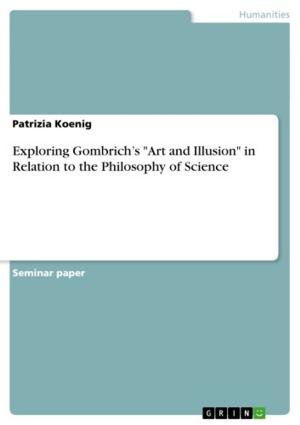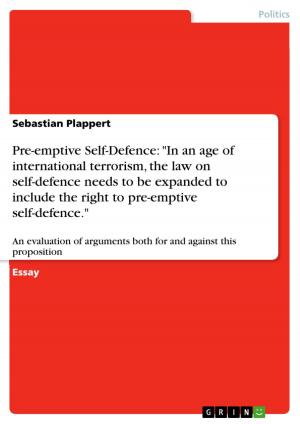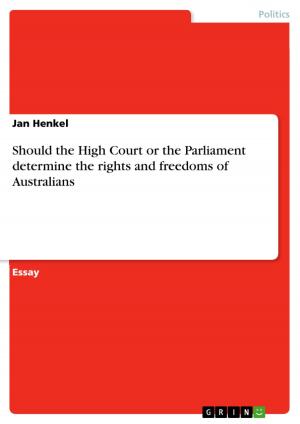Shakespeare - The disturbing world of Richard III and Edmund
The disturbing world of Richard III and Edmund
Fiction & Literature, Literary Theory & Criticism, British| Author: | Tanja Lins | ISBN: | 9783638452458 |
| Publisher: | GRIN Publishing | Publication: | January 7, 2006 |
| Imprint: | GRIN Publishing | Language: | English |
| Author: | Tanja Lins |
| ISBN: | 9783638452458 |
| Publisher: | GRIN Publishing |
| Publication: | January 7, 2006 |
| Imprint: | GRIN Publishing |
| Language: | English |
Seminar paper from the year 2005 in the subject English Language and Literature Studies - Literature, grade: 90% (High Distinction-highest), Monash University Melbourne (School of Literature), course: Shakespeare- Interpretations and Transmutations, 16 entries in the bibliography, language: English, abstract: 'Now is the winter of our discontent made glorious summer by this sun of York' (Richard III, 1.1.1). The famous opening scene of the 'history play' Richard III is known throughout the world and not a few spectators have been fascinated by the character of Richard described by Greenblatt as the 'monster of evil' or the 'virtual devil incarnate' (1997, p.507). In the play itself, Richard is characterized by Margaret as 'elvish-marked, abortive rooting hog' (1.3.227). The play focuses on Richard, who murders his way to the crown. Shakespeare's Edmund in King Lear shows as well a high amount of ruthlessness. Greenblatt, again, states that 'language' and 'social order' are 'merely arbitrary constraints' or 'obstacles' in the way of the 'triumph of his will' (1997, p.2309). He 'seethes' with 'murderous resentment' over the advantages of his brother Edgar, who is a legitimate child (Cohen 1997, p.2309). Whilst generally agreeing on the villainy of both characters, scholarly attention given to them has been generally less convergent over the years. According to Oestreich-Hart (2000), Richard has been described as an 'intrepid warrior', a 'comic or satirical Vice', a diabolic Machiavel', 'a heartless villain of Senecan melodrama', 'a proficient rhetorican' or even a 'spurned child' (p.242). Edmund, the subplot character of King Lear, has been described as 'a most vile' (Utterback 1976, p.203) or 'most toad-spotted traitor' (5.3.137). Due to the fact that both characters show tendencies making them extremely atrocious and unpredictable, the aim of the essay, in contrast, is to explore the idea of Richard and Edward (Folio- version) being psychopaths according to our understanding of the term in our modern world. Psychopaths in literature are quite common and they are extremely fascinating, because they ...look and dress the same way as most businessmen, they may even use the same language. Some of these people are fairly persuasive, they can manipulate, they're very charming, some of them even charismatic. And a lot of people, they like them, they think they're kind of fun to be around, but it takes a long time before you can figure out that something is really amiss here. (R. Hare, Abc Radio National,, July 18, 2004) These features make psychopaths extremely interesting and compelling. Does Shakespeare portray characters who remind of psychopaths as well?
Seminar paper from the year 2005 in the subject English Language and Literature Studies - Literature, grade: 90% (High Distinction-highest), Monash University Melbourne (School of Literature), course: Shakespeare- Interpretations and Transmutations, 16 entries in the bibliography, language: English, abstract: 'Now is the winter of our discontent made glorious summer by this sun of York' (Richard III, 1.1.1). The famous opening scene of the 'history play' Richard III is known throughout the world and not a few spectators have been fascinated by the character of Richard described by Greenblatt as the 'monster of evil' or the 'virtual devil incarnate' (1997, p.507). In the play itself, Richard is characterized by Margaret as 'elvish-marked, abortive rooting hog' (1.3.227). The play focuses on Richard, who murders his way to the crown. Shakespeare's Edmund in King Lear shows as well a high amount of ruthlessness. Greenblatt, again, states that 'language' and 'social order' are 'merely arbitrary constraints' or 'obstacles' in the way of the 'triumph of his will' (1997, p.2309). He 'seethes' with 'murderous resentment' over the advantages of his brother Edgar, who is a legitimate child (Cohen 1997, p.2309). Whilst generally agreeing on the villainy of both characters, scholarly attention given to them has been generally less convergent over the years. According to Oestreich-Hart (2000), Richard has been described as an 'intrepid warrior', a 'comic or satirical Vice', a diabolic Machiavel', 'a heartless villain of Senecan melodrama', 'a proficient rhetorican' or even a 'spurned child' (p.242). Edmund, the subplot character of King Lear, has been described as 'a most vile' (Utterback 1976, p.203) or 'most toad-spotted traitor' (5.3.137). Due to the fact that both characters show tendencies making them extremely atrocious and unpredictable, the aim of the essay, in contrast, is to explore the idea of Richard and Edward (Folio- version) being psychopaths according to our understanding of the term in our modern world. Psychopaths in literature are quite common and they are extremely fascinating, because they ...look and dress the same way as most businessmen, they may even use the same language. Some of these people are fairly persuasive, they can manipulate, they're very charming, some of them even charismatic. And a lot of people, they like them, they think they're kind of fun to be around, but it takes a long time before you can figure out that something is really amiss here. (R. Hare, Abc Radio National,, July 18, 2004) These features make psychopaths extremely interesting and compelling. Does Shakespeare portray characters who remind of psychopaths as well?















